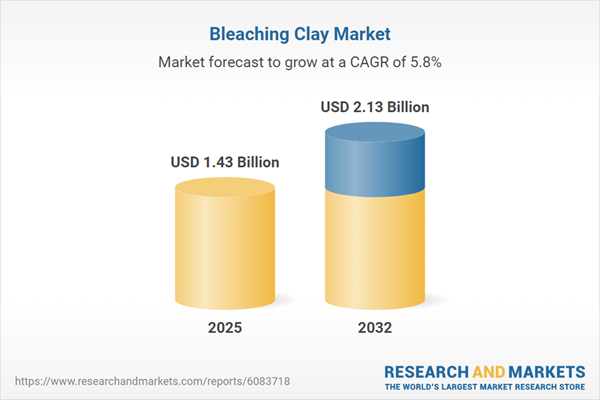Speak directly to the analyst to clarify any post sales queries you may have.
Senior executives in industrial processing and sustainability are increasingly focused on the bleaching clay market as evolving regulations and technological advances create new opportunities and challenges for supply chains and operational performance.
Market Snapshot: Bleaching Clay Market Growth and Trends
The bleaching clay market expanded from USD 1.35 billion in 2024 to USD 1.43 billion in 2025 and is on track for a steady CAGR of 5.84%, likely exceeding USD 2.13 billion by 2032. Growth is underpinned by increased demand for high-purity products, continual advancements in activation techniques, and stringent regulations worldwide that demand improved environmental and quality performance. Markets are further shaped by supply chain refinements and industry-specific requirements for bespoke adsorbent solutions, particularly in industries prioritizing product quality and regulatory compliance.
Scope & Segmentation of the Bleaching Clay Market
This research provides comprehensive analysis for decision-makers aiming to align procurement and technology strategies. Coverage includes use cases, technological progress, shifts in supplier approaches, and geographical priorities across the bleaching clay market:
- Application: Includes mineral oil bleaching such as lubricants and transformer oil, vegetable oil applications from canola to sunflower oil, and industrial as well as municipal wastewater treatment. Each application reflects unique requirements for purity and process efficiency.
- End Use: Spans cosmetics and personal care sectors (haircare, makeup, skincare), environmental applications for soil remediation and wastewater processing, food and beverage industries such as beer, wine, and sugar refining, along with pharmaceutical and chemical uses. These sectors drive incremental adoption based on evolving consumer expectations and compliance needs.
- Source: Analyzes the roles of bentonite, Fuller's earth, and kaolin in delivering distinct adsorption profiles and regeneration abilities to meet technical and operational demands.
- Type: Assesses acid-activated, natural, and synthetic bleaching clays, each defined by specific activation methods and surface characteristics, offering tailored performance for targeted industrial needs.
- Activation Process: Reviews chemical and physical activation processes. Each method influences efficacy and supports customization for enhanced contaminant removal in distinct applications.
- Geography: Explores regional dynamics across the Americas (covering both North and Latin America), Europe, the Middle East and Africa, and Asia-Pacific, highlighting market maturity, supply chain structure, and consumption profiles relevant to global and regional procurement plans.
- Industry Players: Profiles a spectrum of suppliers, from established multinational providers to regional and emerging companies leveraging technology-driven differentiation and local responsiveness.
Key Takeaways for Strategic Decision-Making
- Selection of bleaching clay increasingly supports sustainability objectives, integrating into broader environmental commitments and advancing product quality in manufacturing operations.
- Industrial users show a clear trend towards high-performance, customized grades to address shifting regulatory expectations, consumer pressure, and ecological mandates across a variety of sectors.
- Innovation in both activation processes and digital process monitoring drives operational efficiency, reducing downtime while improving removal of contaminants and trace impurities.
- Strategic partnerships, including supplier collaborations and R&D alliances, are expanding the potential application areas and ensuring stronger compliance agility in the face of new regulatory frameworks.
- Regional market conditions shape technology adoption and supplier preference, with the Asia-Pacific and select American markets seeking capacity growth, and European and Middle Eastern regions emphasizing quality, process integrity, and environmental stewardship.
- Supplier differentiation is tied to proprietary activation technologies, integrated digital solutions for real-time monitoring, and comprehensive technical support services that streamline integration and performance tracking.
Tariff Impact: Strategic Implications of 2025 US Measures
The 2025 US tariffs on bleaching clay have shifted global sourcing and trade structures. Both producers and end users are actively reassessing their supply chain models, increasing sourcing diversity, and developing new partnerships to strengthen resilience. Emphasis on local processing and transparent supply chains is growing, as competition intensifies and strategic multi-sourcing becomes central to mitigating disruptions and supply-related risks.
Methodology & Data Sources
The analysis leverages direct interviews with engineering leads, procurement managers, and regulatory experts, supported by expert panels and data validation. The study rigorously draws upon technical literature, global trade statistics, and real-world case studies, applying structured triangulation to provide senior management with actionable, credible findings.
Why This Report Matters for Senior Leaders
- Supports precise procurement and investment decisions by charting supply chain adaptation, deployment of emerging technologies, and assessing supplier strengths in key global markets.
- Enables businesses to synchronize sustainability goals with market-available bleaching clay solutions and supplier response strategies, supporting compliance and operational targets.
- Equips leadership with insights to proactively address technological, regulatory, and competitive shifts that may influence both immediate operations and long-term strategic outcomes.
Conclusion
With advanced solutions and robust supply strategies reshaping the bleaching clay landscape, executives leveraging timely insights from this research can ensure sustained operational performance and future-ready competitiveness as the industry evolves.
Table of Contents
3. Executive Summary
4. Market Overview
7. Cumulative Impact of Artificial Intelligence 2025
Companies Mentioned
The companies profiled in this Bleaching Clay market report include:- Oil-Dri Corporation of America
- Bentonite Performance Minerals LLC
- Clariant AG
- Quimonda GmbH
- J. M. Huber Corporation
- Tega Industries Limited
- Southern Ion Exchange & Chemicals Limited
- Henan King Clay Technology Co., Ltd
- Sichuan Bentonite Industrial Co., Ltd
Table Information
| Report Attribute | Details |
|---|---|
| No. of Pages | 193 |
| Published | October 2025 |
| Forecast Period | 2025 - 2032 |
| Estimated Market Value ( USD | $ 1.43 Billion |
| Forecasted Market Value ( USD | $ 2.13 Billion |
| Compound Annual Growth Rate | 5.8% |
| Regions Covered | Global |
| No. of Companies Mentioned | 10 |









